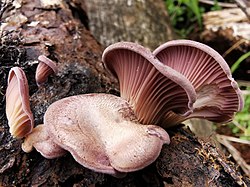| Panus purpuratus | |
|---|---|
 | |
| Scientific classification | |
| Kingdom: | Fungi |
| Division: | Basidiomycota |
| Class: | Agaricomycetes |
| Order: | Polyporales |
| Family: | Panaceae |
| Genus: | Panus |
| Species: | P. purpuratus |
| Binomial name | |
| Panus purpuratus | |
Panus purpuratus is a fungus in the family, Panaceae, first described by Greta Stevenson in 1964. [1] [2] The type species was collected from fallen wood in a coastal forest in Waikanae in 1949. [2] The species is endemic to New Zealand. [3]